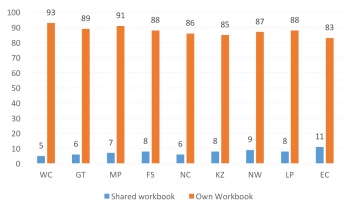Workbook and textbook availability - Adding learners' voices
In 2012, Limpopo was at the centre of a media storm when textbooks were not delivered to schools in the province. After high-profile litigation, many schools only received their books toward the second half of the year. Dr Linda Zuze examines data from the 2015 Trends in International Mathematics and Science Study (TIMSS) to determine the more recent textbook situation in schools across South Africa.
Textbooks, workbooks and teacher guides are core learning and teaching support materials required for curriculum coverage. The South African government has made ambitious promises about textbook provisioning.
The Department of Basic Education (DBE) is working towards providing one textbook per learner per subject in every school. However, the process of procurement and delivering these materials varies from province to province.
The gap between policy and practice remains wide in many parts of the country. There have been textbook shortages in other provinces, such as KwaZulu-Natal, indicating that it is a national issue. Turning the spotlight on textbook delivery has been good for raising awareness of a problem of which the general public previously knew little about. In overcrowded classrooms, a textbook may mean that children at least have a more structured approach to covering their curriculum. They don’t have to spend valuable class time copying notes from the blackboard and teachers have more time and flexibility to focus on lesson coverage. These crises have also provided us with excellent insights into the complexity of the issue and the many actors involved.
Asking the learners
The discussion about textbook availability usually takes place among policy makers, public interest organisations and legal experts. The 2015 Trends in International Mathematics and Science Study (TIMSS) added learners’ voices to the conversation by asking them about whether or not they had their own textbooks or workbooks, shared these resources with other learners or did not have any access to them at all. Among grade 5 learners who took part in the TIMSS study, the vast majority had access to their own workbooks (86% in no-fee public schools, 91% in fee-paying public schools and 83% in independent schools). There were provincial differences with 93% of learners in the Western Cape and 91% in Mpumalanga having greater access to an individual workbook compared to 85% of learners in KwaZulu-Natal and 83% in the Eastern Cape.
Percentage of learners with access to a workbook by province, TIMSS 2015
Among grade 9 learners, 82% had access to their own mathematics textbook and 69% to their own science textbook. Again, textbook availability was lower in the country’s least resourced no-fee schools. Seventy-eight per cent of learners in no-fee public schools had their own mathematics textbook in 2015, compared with 88% in public fee-paying schools and 85% in independent schools. The gap in science textbook ownership between public and independent schools was even wider. Sixty-six per cent of grade 9 learners in no-fee schools had their own science textbook compared to 74% in fee-paying and 82% in independent schools.
Percentage of learners who own a textbook by school type, TIMSS 2015
Sole access to grade 9 mathematics and science textbooks also varied across the provinces. In the Eastern Cape, 77% of learners had sole access to a mathematics textbook and in KwaZulu-Natal, only 72%. In the Western Cape (90%) and Gauteng (88%), learners were more fortunate.
Textbook shortage impacts TIMSS
Although workbook and textbook coverage might be better than we thought, we need to consider these findings carefully. The fact that 17% of grade 5 learners in the Eastern Cape did not have their own workbooks is concerning given that this province had the poorest results in TIMSS 2015. Also, the problem was more widespread than just one province. Twenty-eight per cent of grade 9 learners in KwaZulu-Natal were without mathematics textbooks and a staggering 57% of learners in the same province were without science textbooks a few years before their crucial
National Senior Certificate Examination.
Percentage of learners who own a textbook by school type, TIMMS 2015
Not there yet
The December 2015 Constitutional Court judgement was very clear. The right to basic education includes ensuring that every learner has access to required textbooks at the beginning of the academic year. The DBE has set up a call centre so that school representatives can raise concerns about textbook delivery. This shows that the department is trying to address any delays that may arise in the future. While we recognise that many of our poorest learners have a level of access to mathematics and science learning and teaching support materials, there is room for improvement.
There are also clear differences between provincial reports on the delivery of these materials to schools and the distribution of books to learners. The 2015 TIMSS results show that full coverage has not yet been achieved and that access to learning and teaching support materials is dependent on the subject area. It also suggests that some of the best information about how textbooks are delivered and used comes from the learners themselves.
This needs to be considered when this issue is monitored in the future.
Author: Dr Linda Zuze, a former chief research specialist at the HSRC’s Education and Skills Development programme.


